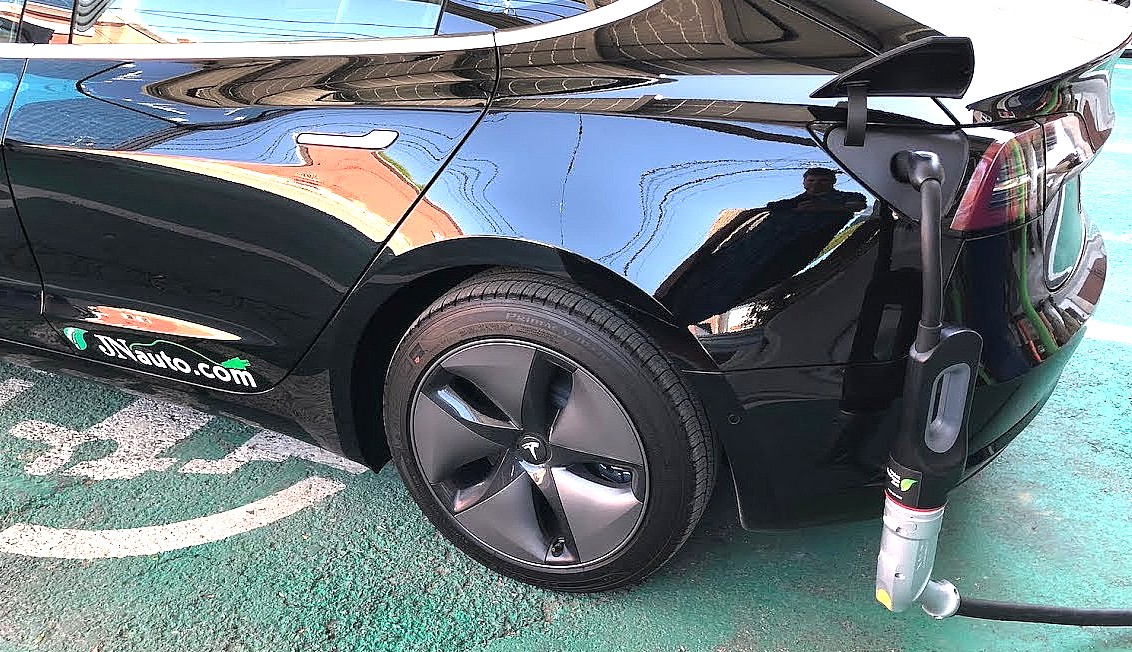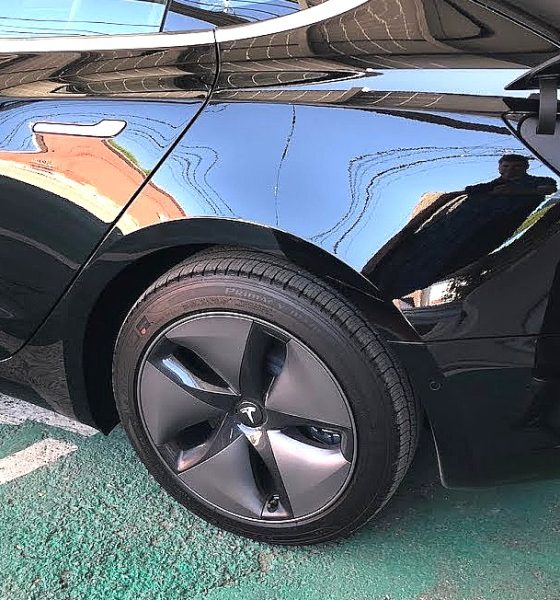

News
Tesla Model 3 finally gets a CHAdeMO quick charge adapter
Tesla is finally offering a CHAdeMO quick charge adapter for the Model 3 in its online store. The page for the accessory went live earlier today, giving Model 3 owners additional options for fast-charging outside of the Supercharger network and leverage the vast DC fast-charging network. With this update, Tesla’s existing lineup of vehicles, the Model S, Model X, and Model 3, are now all compatible with CHAdeMO’s expansive network of chargers.
Similar to the Supercharger Network, CHAdeMO is a quick charging method for battery electric vehicles. Proposed as a global industry standard in 2010 by a group of five Japanese automakers, CHAdeMO steadily grew into a network of 23,000 global charge points, which include 9,200 in Europe, 3,200 in North America, and 7,600 in Japan.
Tesla, for its part, has offered a CHAdeMO adapter for the Model S and Model X for years. When the Model 3 was released, it was widely assumed that the new sedan would be compatible with the CHAdeMO adapters of its larger siblings, but this was not the case. The EVgo Fast Charging Network confirmed this on Twitter.
Tesla, for its part, has shown indications that it is looking to bring CHAdeMO charging to the Model 3. A page for a CHAdeMO adapter that was supposedly compatible with the Model 3 briefly went live in the vehicle’s “adapters” section at Tesla’s online store last June, but the page was quickly updated to remove the item. Tesla has also maintained that its vehicles will eventually be capable of recharging their batteries using all “compelling” public quick charge networks, hinting further at CHAdeMO compatibility in the near future.
Tesla’s release of the Model 3’s CHAdeMO adapter comes as the electric car maker continues the international rollout of the Model 3. This could prove strategic in territories where CHAdeMO is popular, such as Japan. Having a CHAdeMO adapter ready for the Model 3’s upcoming deliveries in Japan ensures that customers in the Asian country could charge at the DC fast chargers without any issues.
Tesla’s Superchargers are arguably the gold standard when it comes to electric vehicle charging systems, and with the ongoing expansion of V3 chargers, the network is bound to become even more impressive and formidable. Despite this, the company has demonstrated a willingness to make its vehicles compatible with chargers outside its expansive, proprietary network.
This was shown in the company’s release of CCS adapters for the Model S and X in Europe, as well as CHAdeMO adapters for the two flagship vehicles. Tesla has also started rolling out Superchargers with both its proprietary connector and a CCS plug in Europe, in order to cater to the Model 3, which is being shipped with a CCS plug by default in the region.
Tesla’s CHAdeMO adapter for the Model 3, which retails for $450 each and is capable of charging at speeds of up to 50 kW, could be accessed here.

News
Tesla FSD fleet is nearing 7 billion total miles, including 2.5 billion city miles
As can be seen on Tesla’s official FSD webpage, vehicles equipped with the system have now navigated over 6.99 billion miles.

Tesla’s Full Self-Driving (Supervised) fleet is closing in on almost 7 billion total miles driven, as per data posted by the company on its official FSD webpage.
These figures hint at the massive scale of data fueling Tesla’s rapid FSD improvements, which have been quite notable as of late.
FSD mileage milestones
As can be seen on Tesla’s official FSD webpage, vehicles equipped with the system have now navigated over 6.99 billion miles. Tesla owner and avid FSD tester Whole Mars Catalog also shared a screenshot indicating that from the nearly 7 billion miles traveled by the FSD fleet, more than 2.5 billion miles were driven inside cities.
City miles are particularly valuable for complex urban scenarios like unprotected turns, pedestrian interactions, and traffic lights. This is also the difference-maker for FSD, as only complex solutions, such as Waymo’s self-driving taxis, operate similarly on inner-city streets. And even then, incidents such as the San Francisco blackouts have proven challenging for sensor-rich vehicles like Waymos.
Tesla’s data edge
Tesla has a number of advantages in the autonomous vehicle sector, one of which is the size of its fleet and the number of vehicles training FSD on real-world roads. Tesla’s nearly 7 billion FSD miles then allow the company to roll out updates that make its vehicles behave like they are being driven by experienced drivers, even if they are operating on their own.
So notable are Tesla’s improvements to FSD that NVIDIA Director of Robotics Jim Fan, after experiencing FSD v14, noted that the system is the first AI that passes what he described as a “Physical Turing Test.”
“Despite knowing exactly how robot learning works, I still find it magical watching the steering wheel turn by itself. First it feels surreal, next it becomes routine. Then, like the smartphone, taking it away actively hurts. This is how humanity gets rewired and glued to god-like technologies,” Fan wrote in a post on X.
News
Tesla starts showing how FSD will change lives in Europe
Local officials tested the system on narrow country roads and were impressed by FSD’s smooth, human-like driving, with some calling the service a game-changer for everyday life in areas that are far from urban centers.

Tesla has launched Europe’s first public shuttle service using Full Self-Driving (Supervised) in the rural Eifelkreis Bitburg-Prüm region of Germany, demonstrating how the technology can restore independence and mobility for people who struggle with limited transport options.
Local officials tested the system on narrow country roads and were impressed by FSD’s smooth, human-like driving, with some calling the service a game-changer for everyday life in areas that are far from urban centers.
Officials see real impact on rural residents
Arzfeld Mayor Johannes Kuhl and District Administrator Andreas Kruppert personally tested the Tesla shuttle service. This allowed them to see just how well FSD navigated winding lanes and rural roads confidently. Kruppert said, “Autonomous driving sounds like science fiction to many, but we simply see here that it works totally well in rural regions too.” Kuhl, for his part, also noted that FSD “feels like a very experienced driver.”
The pilot complements the area’s “Citizen Bus” program, which provides on-demand rides for elderly residents who can no longer drive themselves. Tesla Europe shared a video of a demonstration of the service, highlighting how FSD gives people their freedom back, even in places where public transport is not as prevalent.
What the Ministry for Economic Affairs and Transport says
Rhineland-Palatinate’s Minister Daniela Schmitt supported the project, praising the collaboration that made this “first of its kind in Europe” possible. As per the ministry, the rural rollout for the service shows FSD’s potential beyond major cities, and it delivers tangible benefits like grocery runs, doctor visits, and social connections for isolated residents.
“Reliable and flexible mobility is especially vital in rural areas. With the launch of a shuttle service using self-driving vehicles (FSD supervised) by Tesla in the Eifelkreis Bitburg-Prüm, an innovative pilot project is now getting underway that complements local community bus services. It is the first project of its kind in Europe.
“The result is a real gain for rural mobility: greater accessibility, more flexibility and tangible benefits for everyday life. A strong signal for innovation, cooperation and future-oriented mobility beyond urban centers,” the ministry wrote in a LinkedIn post.
News
Tesla China quietly posts Robotaxi-related job listing
Tesla China is currently seeking a Low Voltage Electrical Engineer to work on circuit board design for the company’s autonomous vehicles.

Tesla has posted a new job listing in Shanghai explicitly tied to its Robotaxi program, fueling speculation that the company is preparing to launch its dedicated autonomous ride-hailing service in China.
As noted in the listing, Tesla China is currently seeking a Low Voltage Electrical Engineer to work on circuit board design for the company’s autonomous vehicles.
Robotaxi-specific role
The listing, which was shared on social media platform X by industry watcher @tslaming, suggested that Tesla China is looking to fill the role urgently. The job listing itself specifically mentions that the person hired for the role will be working on the Low Voltage Hardware team, which would design the circuit boards that would serve as the nervous system of the Robotaxi.
Key tasks for the role, as indicated in the job listing, include collaboration with PCB layout, firmware, mechanical, program management, and validation teams, among other responsibilities. The role is based in Shanghai.
China Robotaxi launch
China represents a massive potential market for robotaxis, with its dense urban centers and supportive policies in select cities. Tesla has limited permission to roll out FSD in the country, though despite this, its vehicles have been hailed as among the best in the market when it comes to autonomous features. So far, at least, it appears that China supports Tesla’s FSD and Robotaxi rollout.
This was hinted at in November, when Tesla brought the Cybercab to the 8th China International Import Expo (CIIE) in Shanghai, marking the first time that the autonomous two-seater was brought to the Asia-Pacific region. The vehicle, despite not having a release date in China, received a significant amount of interest among the event’s attendees.








